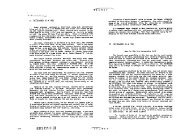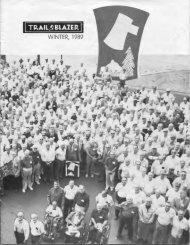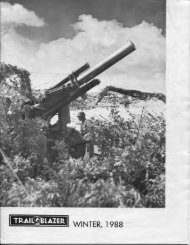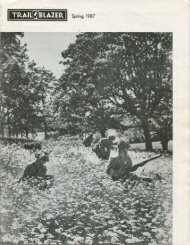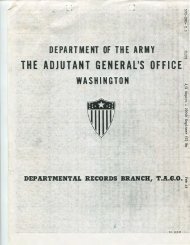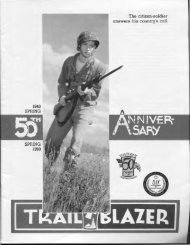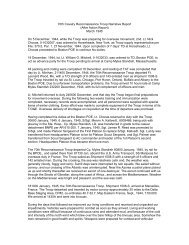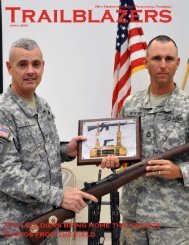Download - 70th Infantry Division Association
Download - 70th Infantry Division Association
Download - 70th Infantry Division Association
You also want an ePaper? Increase the reach of your titles
YUMPU automatically turns print PDFs into web optimized ePapers that Google loves.
I remember I was the one who told several rifle platoons about this attack before we went into battle. Part<br />
of our company was in a warehouse and I was in the process of telling my fellows about the attack when<br />
the officer in the building said, "Bru, you might as well tell the story to everyone in the building." And I did.<br />
However, I wasn't told it was going to be a raid. I thought if we took Oeting town, we would push on into<br />
Germany.<br />
As the attack moved along through the morning, I remember the Germans opened up with 88 shells and I<br />
jumped in a ravine headfirst and felt something under me. It was a dead G.I. who had been killed several<br />
weeks before. He was frozen solid. His face was only two or three inches from mine and his eyes were<br />
wide open. The bottom part of his body was covered with snow, but the wind had blown the snow from his<br />
face. I had dreams about him for many nights after that.<br />
We did manage to get some people into the town of Oeting but withdrew to high ground around the town.<br />
We fired our first area target with three 60 mm mortars here. All three guns firing at once covered a wide<br />
area in front of our troops. After we fired the mission, I heard Lt. Cheezen ask the rifle platoons over the<br />
radio if anyone of our guys got hurt and the answer was "no". I was real proud of our gunners that day.<br />
Another thing happened that evening. Lt. Cheezen came back to me and said, "Brut, a German has been<br />
sniping at us from the rear and we have to get him out of there." Somehow the German got into a dug-out<br />
behind the troops and he was shooting our people in the back. So we knocked down one of the 60 mm<br />
mortars and just took the barrel. Jake and I crawled within range of the dug-out. Jake was the gunner and<br />
I was the second gunner.<br />
We were going to shoot within a range of 100 to 150 feet in front of us without a base plate or tripod and<br />
no sights, just a 60 mm mortar barrel. It could be done but if we failed we could be killed or kill some of<br />
our own troops. The shell must go straight up and come down 100 feet in front of us. It was cold but as<br />
Jake was sighting the gun, I looked over at him and he was sweating like it was 90 degrees out. I said to<br />
him, "Jake, this has to be the best shot of your life or I'll never speak to you again." Jake finally said,<br />
"Now; shoot!" I pulled the pin on the shell and let it slide down the barrel. The shell went off and up the<br />
barrel. We could see it going up from the barrel and we couldn't see it coming back down. It hit the dugout<br />
dead center. Jake and I were so shocked that we hit the target that he and I sat there looking at each<br />
other for a couple of minutes. We couldn't believe we did it. The Lieutenant said, "Jake, you should get a<br />
medal", but he never did.<br />
The Germans had tanks. Our weapons would not fire because of the mud in the guns. But we fired<br />
everything we had to fire. A machine gunner whose tripod had been shattered by mortar fire hopped to<br />
his feet and fired the weapon from the hip to disperse an enemy charge. Our 60 mm barrels were red hot.<br />
The U.S. manual says after firing a 60 mm and the barrel gets hot, you are supposed to swap the barrel,<br />
or pour water on it--something to cool it. That day as the Germans were counterattacking, we used so<br />
much ammo that the ammo bearers were complaining about carrying so much ammo for the 60 mm<br />
mortars and 30 caliber machine guns.<br />
After all that killing and wounding of people, we were ordered to withdraw to the rear under the cover of<br />
darkness. We carried our dead and wounded to the rear while the Germans kept the pressure on.<br />
On February 7th, one mile southwest of Oeting, France, we had lightly wounded people, people who were<br />
at the hospital or at battalion aid station who were not coming back because they were wounded. The<br />
fighting was getting tough and casualties were happening faster. We neared the town of Oeting, fighting<br />
one mile southwest of it to take the town. I remember this deal very well because on February 8, our 2nd<br />
Lt. Cheezen got a promotion to 1st Lt. and our casualties were very high. We were relieved by Company<br />
A at 2:00 on February 8 in defensive position near Folkling, France.<br />
As of the night of 7 February, the 884th Field Artillery was placed in direct support of the 276th <strong>Infantry</strong>.<br />
On 9 February, the 274th <strong>Infantry</strong>, which had been in division reserve with the 100th <strong>Division</strong>, returned to<br />
<strong>70th</strong> <strong>Division</strong> control and moved into the line between the 275th and 276th, relieving elements of both. As<br />
a result of this action, the front of the 276th, which had extended from Emmersweiler to Bousbach, was<br />
reduced to a line from Emmersweiler to Gaubivingen. On this front the First Battalion relieved the Second<br />
Battalion (plus Company K) on the right half, the Third Battalion remained on the left and the Second



